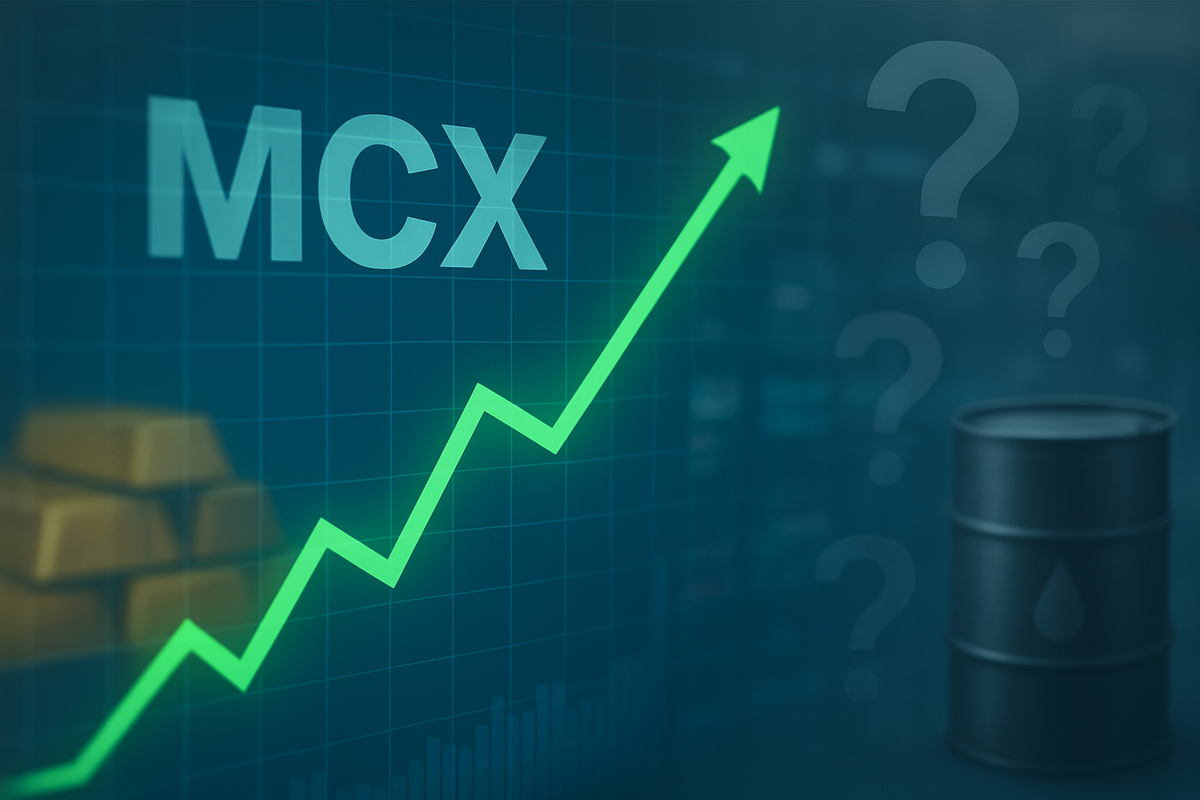
The Multi Commodity Exchange of India (MCX) has delivered an impressive financial performance through fiscal year 2025 and into the first half of fiscal year 2026, reporting a significant surge in profits driven by robust trading volumes and strategic product diversification. This strong showing, however, is unfolding against a backdrop of escalating valuation concerns among market analysts, casting a shadow of uncertainty over the sustainability of its growth trajectory and the broader sentiment around commodity exchanges in India. As of November 17, 2025, the market is grappling with the paradox of a highly profitable enterprise facing skepticism about its premium pricing.
This profit surge, highlighted by a substantial increase in net profits and revenue, positions MCX as a dominant player in India's burgeoning commodity derivatives market. Yet, the divergence in analyst opinions – with some advocating for further upside and others warning of an impending correction – underscores a critical debate: is MCX's current market capitalization justified by its fundamentals and future prospects, or is the sector experiencing a valuation bubble that could impact investor confidence and trigger a broader market reassessment?
MCX's Stellar Performance Meets Skeptical Scrutiny
MCX's recent financial disclosures paint a picture of extraordinary growth. For the second quarter of fiscal year 2026 (July-September 2025), the exchange reported a consolidated net profit of ₹197.47 crore, a robust 28.54% year-on-year (YoY) increase. Revenue from operations soared by 31% YoY to ₹374.23 crore, with EBITDA climbing approximately 32% YoY to ₹270.19 crore. These figures contributed to a stellar first half of FY26 (April-September 2025), where net profit reached ₹400.66 crore, a 51% YoY growth, and revenue from operations jumped 44% YoY to ₹747.44 crore. This momentum follows a strong Q3 FY25 (October-December 2024), which saw a significant turnaround from a previous loss, posting a net profit of ₹160.04 crore and record net sales of ₹301.38 crore.
The catalysts behind this impressive surge are multi-faceted. A primary driver has been the exponential increase in Average Daily Turnover (ADT) of futures and options, which witnessed an 87% YoY jump to ₹411,270 crore in Q2 FY26. This surge is largely attributed to heightened market participation and enhanced liquidity, with the bullion segment notably increasing its share in ADT from 44% to 57%. Furthermore, MCX has strategically expanded its product offerings, introducing new variants like Gold Mini and Gold Ten Futures, monthly expiry contracts for Silver, new Nickel Futures, and monthly Options contracts on the MCX iCOMDEX Bullion Index (MCX BULLDEX). These new instruments have successfully broadened the investor base and stimulated trading activity. Operational efficiencies, cost optimization, and continuous investment in technological advancements, including the successful transition to a new technology platform in October 2023, have also played a crucial role in bolstering profitability. Favorable market conditions, characterized by a stable Indian economy, increased industrial activity, and rising global commodity prices, alongside supportive regulatory frameworks, have collectively created a conducive environment for MCX's expansion.
Despite the compelling financial narrative, the market's reaction has been notably divided. Following the Q2 FY26 results in early November 2025, MCX shares (NSE: MCX) initially saw a modest rise before dipping over 4%, indicating underlying investor caution. This volatility is a recurring theme, as evidenced by an 11.3% intraday decline in January 2025 despite strong Q3 FY25 results. A significant point of contention revolves around valuation. Morgan Stanley has consistently maintained an "Underweight" rating on MCX, citing "expensive valuation" and concerns over the sustainability of revenues concentrated in a few commodities. In early November 2025, they set a target price implying a substantial downside. Conversely, UBS raised its price target, citing strong performance, and Motilal Oswal remains bullish, viewing dips as buying opportunities. This stark disagreement among leading analysts highlights the complex interplay of fundamental strength and market perception regarding MCX's future. The broader market sentiment in late 2025, marked by a "valuation reset" across mid and small-cap segments and global inflation concerns, further exacerbates sensitivity to stretched valuations, making MCX a focal point for this ongoing debate.
Who Gains and Who Faces Headwinds in the Commodity Market
MCX's (NSE: MCX) robust performance firmly places it as the primary beneficiary of India's expanding commodity derivatives market. Its Q1 FY26 consolidated net profit surged by 83% year-on-year, with income from operations reaching a record high, largely due to enhanced trading platforms, product diversification, and increased participation from both institutional and retail investors. The company's stock has reflected this success, seeing significant appreciation and hitting new all-time highs in October 2025. This strong position allows MCX to continue its strategic initiatives, including aggressive product innovation with new derivative products like electricity futures and diversified bullion contracts, and continuous investment in technological enhancements to prevent operational glitches and maintain investor confidence. Furthermore, a planned 1:5 stock split aims to make its shares more accessible to a broader retail investor base, potentially bolstering its equity valuation despite current concerns.
While MCX enjoys a near-monopoly, holding approximately 98% of the market share in terms of the value of commodity futures contracts traded, other exchanges face significant challenges. The National Commodity and Derivatives Exchange (NCDEX), for instance, primarily focuses on agricultural commodities and holds a mere 0.73% share in the overall commodity derivatives turnover. While NCDEX continues to play a vital role in providing a financial safety net for agricultural trades, its growth in the broader commodity market is severely constrained by MCX's dominance in non-agricultural segments. Other smaller players like the Indian Commodity Exchange (ICEX) struggle to compete, often seeking niche specializations or facing funding challenges. The competitive landscape for these smaller exchanges is incredibly tough, forcing them to either innovate within specific niches or explore strategic partnerships to survive.
Beyond the exchanges themselves, various financial market participants stand to win from the burgeoning commodity market, largely facilitated by MCX's activity. Brokers and online trading platforms (e.g., Zerodha, Groww, Upstox) are experiencing increased business as the surge in commodity trading, fueled by technological advancements and user-friendly digital platforms, empowers both retail and institutional traders. These platforms are responding by offering personalized research and advisory insights. Hedgers and speculators also benefit from a vibrant derivatives market, utilizing instruments in gold, crude oil, and agricultural products for risk management and portfolio diversification. Crucially, the Securities and Exchange Board of India's (SEBI) push to allow greater participation from Foreign Portfolio Investors (FPIs), banks, insurers, and pension funds in non-cash settled, non-agricultural commodity derivatives is a game-changer. This move is expected to inject substantial liquidity and lead to more efficient price discovery, primarily benefiting MCX as the market leader, and in turn, creating new avenues for these institutional investors to manage risk and deploy capital within the commodity space.
A Growing Market Under Regulatory Watch
MCX's impressive profit surge and the accompanying valuation debate are not isolated events but rather significant indicators of broader, transformative trends within the Indian commodity derivatives market. This market is projected to expand robustly, from USD 1.18 trillion in 2025 to USD 1.92 trillion by 2031, fueled by several key developments. There's a notable increase in participation, with retail traders now constituting approximately 35% of total traders, a substantial rise driven by user-friendly digital trading platforms. This democratisation of access, coupled with a significant shift towards options contracts and a dominant non-agricultural segment (metals, energy, bullion), underscores a maturing market seeking diversified hedging tools amidst volatile equity markets. Exchanges, led by MCX, are actively investing in technological upgrades and product innovation, such as electricity derivatives and new bullion index options, to capture this burgeoning demand and maintain competitive edge.
The ripple effects of MCX's dominance are profound across the Indian financial ecosystem. While MCX (NSE: MCX) benefits immensely from its near-monopoly, holding approximately 98% of the market share, competitors like the National Commodity and Derivatives Exchange (NCDEX) face an uphill battle. NCDEX, primarily focused on agricultural products, has been particularly impacted by SEBI's extended ban on futures trading in several agricultural commodities until January 31, 2025. This regulatory intervention, aimed at curbing food inflation, severely limits NCDEX's core trading volumes and highlights the vulnerability of specialized exchanges to policy shifts. Conversely, brokers, online trading platforms, and technology providers all stand to gain from the overall growth in commodity trading volumes, as increased retail and institutional interest translates into more business opportunities and demand for robust trading infrastructure.
The Securities and Exchange Board of India (SEBI) plays a crucial, dual role in this evolving landscape: fostering growth while ensuring market integrity and stability. SEBI is actively pursuing initiatives to deepen and broaden the market, including proposals to allow institutional investors like banks, insurance companies, pension funds, and Foreign Portfolio Investors (FPIs) to trade in non-agricultural commodity derivatives. Such measures are expected to inject substantial liquidity and sophistication, primarily benefiting MCX as the market leader. Concurrently, SEBI maintains stringent oversight, as evidenced by its fine on MCX in June 2025 for disclosure issues related to its new trading platform rollout, underscores its commitment to operational stability and transparency. The extended ban on agricultural commodity futures also reflects SEBI's interventionist stance in managing inflation, a consistent regulatory approach with historical precedents in India's commodity market.
Historically, India's commodity markets have experienced cycles of rapid growth and regulatory intervention, often driven by government efforts to manage price volatility and ensure essential commodity availability. The current emphasis on technological evolution, exemplified by MCX's successful platform migration, echoes the lessons from past eras where exchanges that lagged in technology, like the BSE in the early 2000s, lost market dominance. The ongoing efforts to encourage greater institutional and foreign participation mirror the evolution of more mature global markets, where diverse participant bases contribute to deeper liquidity and better price discovery. This period marks an "inflection point" where technology, regulation, and investor interest converge to redefine the role of commodity markets in India's financial landscape, making the balance between MCX's growth and its valuation a critical barometer for the sector's future.
The Road Ahead: Navigating Growth and Volatility
The immediate future for MCX (NSE: MCX) and the broader Indian commodity derivatives market in late 2025 and into 2026 is poised for continued dynamism, characterized by both significant growth opportunities and persistent challenges. In the short term, MCX is expected to benefit from the sustained momentum generated by innovative product launches, such as electricity derivatives approved by SEBI in June 2025, which tap into India's massive electrification drive. Increased institutional activity, driven by recent regulatory changes, will further deepen market liquidity, while ongoing global and domestic factors influencing commodity prices (e.g., gold, silver, crude oil) will likely maintain high trading volumes. However, periods of profit-taking and market corrections are anticipated, particularly following significant rallies, with analysts advising caution on highly valued assets.
Looking further ahead, beyond 2026, the Indian commodity derivatives market is considered nascent compared to the equity market, indicating substantial untapped potential. The market is projected to expand significantly, driven by a diversified participant base that includes a wider array of institutional investors, foreign entities, mutual funds, and portfolio managers. As India aims to become a $5 trillion economy, commodities are poised to play a crucial role as a core growth driver, supported by increasing global demand. The energy sector, particularly power and gas markets, is projected to be a major driver of growth in commodity trading value pools by 2030, potentially surpassing traditional segments. Long-term forecasts for precious metals also remain bullish, with gold potentially reaching $5,000 per ounce by 2026 and silver benefiting from growing industrial applications.
To capitalize on these opportunities and mitigate challenges, strategic pivots and adaptations will be crucial for all market participants. For MCX, this means leveraging its first-mover advantage in new segments like electricity futures, continuous product innovation, and relentless investment in technological upgrades to maintain its dominant market share. Proactive engagement with regulatory compliance and addressing operational concerns will also be vital for sustaining trust. Other market participants, including brokers and investors, must embrace digital transformation, utilize AI-driven analytics, and prioritize diversification across asset classes. There is also a pressing need for intensified financial literacy efforts to educate retail investors and farmers, enabling them to effectively utilize hedging tools and make informed decisions.
The market faces several challenges, including potential regulatory hurdles from overlapping jurisdictions and unpredictable policy shifts, which can deter investment. While some contracts boast high liquidity, others suffer from insufficient depth, hindering efficient price discovery. Limited grassroots participation, infrastructure gaps in warehousing and transportation, and restrictions on banking sector involvement also pose significant barriers to comprehensive market development. Potential scenarios range from an optimistic growth trajectory, fueled by sustained regulatory support and widespread technology adoption, to a moderate expansion tempered by existing challenges, or even periods of increased volatility and regulatory tightening in response to excessive speculation. The ongoing refinement of SEBI's regulatory framework, coupled with continuous technological advancements and evolving investor behavior, will ultimately shape the trajectory of this critical financial sector.
Conclusion: A Balancing Act for India's Commodity Market Leader
MCX's recent profit surge is a testament to its strategic foresight, operational efficiency, and the burgeoning potential of India's commodity derivatives market. The exchange has successfully capitalized on increased trading volumes, particularly in bullion, and its aggressive diversification into new products like electricity derivatives. This performance solidifies MCX's position as the undisputed leader, attracting significant investor interest and driving innovation across the sector.
However, the persistent valuation concerns, highlighted by the divergence in analyst opinions and the stock's occasional volatility, underscore a critical balancing act. While MCX's fundamentals appear robust, the market is scrutinizing whether its current premium valuation is sustainable, especially in a broader environment of "valuation resets" and global economic uncertainties. The ability of MCX to consistently deliver on its growth promises, manage operational risks, and effectively communicate its long-term strategy will be key to assuaging these concerns.
Moving forward, the Indian commodity market is at an inflection point. Regulatory initiatives from SEBI aimed at deepening institutional participation, coupled with ongoing technological advancements, promise to unlock further growth. Yet, challenges such as regulatory unpredictability, infrastructure deficits, and the need for greater financial literacy among grassroots participants remain. Investors should watch for continued product innovation from MCX, the impact of new institutional inflows, any shifts in SEBI's regulatory stance on agricultural commodities, and how MCX navigates its valuation narrative in the coming months. The success of MCX, and indeed the entire commodity exchange ecosystem, will depend on its ability to adapt to these evolving dynamics, ensuring sustained growth while maintaining market integrity and investor confidence.
This content is intended for informational purposes only and is not financial advice







